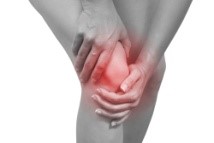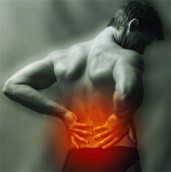Why the bum? |
| 1. Pelvic stabilisation The gluteus maximus is the strongest and biggest muscle of the body. It plays an important role in pelvic stabilisation. Co-contraction of the gluteus maximus with the psoas major (see picture on the right) contributes to lumbo-sacral (lower back and pelvic region) stabilisation. |
The gluteus maximus provides stability to the sacroiliac joint (SI joint) (see picture on the left) by bracing and compression. Excess movement at the SI joint would compromise the intervertebral joints and disc and could lead to SI joint dysfunction and low back pain. The gluteal muscles stabilise the hip by counteracting gravity and maintaining proper leg alignment.

1. Spine stabilisation
The gluteus maximus allows us to maintain an upright position. The gluteus maximus also provides lower back stability through its connection with the erector spinae (deep muscles in the back that keep the back upright). Some of its fibres are continuous with the fibres of the erector spinae. A contraction of the gluteus maximus will generate tension in the erector spinae muscle on the same side, providing stiffness to the spinal column.
2. Movement
The gluteus maximus is a hip extensor (hip extension is the movement where the leg moves towards the back of the body). The gluteal muscles play a very big role in sufficient and efficient movement. Weak gluteal muscles will cause movement problems and compensations that can lead to injuries.
Gluteal amnesia
Gluteal amnesia is a condition where your body can’t or forgets how to properly activate the gluteal muscles, whether it’s due to postural flaws or lack of use. As a result, you may lose the ability to move your hips through a full range of motion which adds stress to your knee, lower back, and even your shoulder joints!
The gluteus maximus allows us to maintain an upright position. The gluteus maximus also provides lower back stability through its connection with the erector spinae (deep muscles in the back that keep the back upright). Some of its fibres are continuous with the fibres of the erector spinae. A contraction of the gluteus maximus will generate tension in the erector spinae muscle on the same side, providing stiffness to the spinal column.
2. Movement
The gluteus maximus is a hip extensor (hip extension is the movement where the leg moves towards the back of the body). The gluteal muscles play a very big role in sufficient and efficient movement. Weak gluteal muscles will cause movement problems and compensations that can lead to injuries.
Gluteal amnesia
Gluteal amnesia is a condition where your body can’t or forgets how to properly activate the gluteal muscles, whether it’s due to postural flaws or lack of use. As a result, you may lose the ability to move your hips through a full range of motion which adds stress to your knee, lower back, and even your shoulder joints!

Testing to see if the gluteal muscles are weak?
There is a test you can do to determine if your glutes are weak. To start this test, stand in front of a chair (facing the chair) and with your feet under the chair and your knees touching the seat. Now squat down and try not to let your knees push into the chair. If you find that your knees are hitting the chair or you are even moving the chair, your glutes are not working properly. If the knees come forward into the chair, you are initiating the squat movement with your quads. This places unnecessary stress on the knees and ankles. The object of this assessment is to try to initiate the squat from the hips (i.e. stick your butt out before your try to bend your knees). Starting a squat from the hips will engage the gluteus maximus.
What causes the gluteal muscles to weaken?
When considering the human body, we know that some muscles are more prone to inhibition than others, and the glutes are one of these “easily-inhibited” muscles. Here are some of the reasons your glutes may be weak or inhibited:
There is a test you can do to determine if your glutes are weak. To start this test, stand in front of a chair (facing the chair) and with your feet under the chair and your knees touching the seat. Now squat down and try not to let your knees push into the chair. If you find that your knees are hitting the chair or you are even moving the chair, your glutes are not working properly. If the knees come forward into the chair, you are initiating the squat movement with your quads. This places unnecessary stress on the knees and ankles. The object of this assessment is to try to initiate the squat from the hips (i.e. stick your butt out before your try to bend your knees). Starting a squat from the hips will engage the gluteus maximus.
What causes the gluteal muscles to weaken?
When considering the human body, we know that some muscles are more prone to inhibition than others, and the glutes are one of these “easily-inhibited” muscles. Here are some of the reasons your glutes may be weak or inhibited:

1. Inactivity
Probably the biggest reason why the glutes shut down is due to inactivity. If you fail to consistently activate a muscle, and you fail to regularly activate a muscle to high levels of capacity, it will inevitably quit working properly. If you spend long periods of time sitting in a chair, then the front of the hips (psoas) become short and tight, while the back of the hips (gluteal muscles) become long and weak. Soon the body forgets how to use the gluteal muscles because it will divert the neural signal intended for them to a stronger muscle close by to do the job instead. Gluteal inhibition can negatively impact posture, and poor posture can further inhibit the glutes, thereby creating a downward spiral in gluteal function.
Probably the biggest reason why the glutes shut down is due to inactivity. If you fail to consistently activate a muscle, and you fail to regularly activate a muscle to high levels of capacity, it will inevitably quit working properly. If you spend long periods of time sitting in a chair, then the front of the hips (psoas) become short and tight, while the back of the hips (gluteal muscles) become long and weak. Soon the body forgets how to use the gluteal muscles because it will divert the neural signal intended for them to a stronger muscle close by to do the job instead. Gluteal inhibition can negatively impact posture, and poor posture can further inhibit the glutes, thereby creating a downward spiral in gluteal function.

2. Pain
Pain is a huge inhibitor of the gluteus maximus. The glutes can become inhibited with just about any lower body or spinal injury. Following injury, most people simply keep on keeping on, and their movement patterns suffer. Rather than experiencing proper glute function during movement, they rely on other muscles to get the job done. This will cause many postural and gait compensations. The body is resilient and will find a way to prevail. Next time you go for an early morning drive, pay attention to the joggers. You’ll notice that not many of them appear athletic or possess good running posture. Sadly, most look like they’re “speed-limping.” This is due to compensating for, most likely, weak glutes.
What can happen if my gluteal muscles are weak?
Inhibition and delayed activation of the gluteal muscles can in time lead to weakness of these muscles. Gluteal inhibition negatively affects performance and lower body strength and is a root cause for many injuries and chronic pain. Injuries that can result from weakened glutes include:
Pain is a huge inhibitor of the gluteus maximus. The glutes can become inhibited with just about any lower body or spinal injury. Following injury, most people simply keep on keeping on, and their movement patterns suffer. Rather than experiencing proper glute function during movement, they rely on other muscles to get the job done. This will cause many postural and gait compensations. The body is resilient and will find a way to prevail. Next time you go for an early morning drive, pay attention to the joggers. You’ll notice that not many of them appear athletic or possess good running posture. Sadly, most look like they’re “speed-limping.” This is due to compensating for, most likely, weak glutes.
What can happen if my gluteal muscles are weak?
Inhibition and delayed activation of the gluteal muscles can in time lead to weakness of these muscles. Gluteal inhibition negatively affects performance and lower body strength and is a root cause for many injuries and chronic pain. Injuries that can result from weakened glutes include:
1. Hamstring strains
Due to delayed gluteus maximus activity, the hamstring muscles become dominant during hip extension, which can cause hamstring strains. A lot of athletes that pulled a hamstring keep suffering re-injuries despite their focus and efforts to strengthen the hamstrings. They are reinforcing a compensation pattern instead of reactivating their inhibited glutes.
2. Low back pain
Gluteus maximus activation plays an important role in stabilising the pelvis during the task of lifting. Delayed gluteus maximus activation causes excessive compensation of the back extensors. The lower back becomes dominant and the glutes are neglected. The body is an interconnected system. If the muscles do not fire where and when they’re supposed to, other muscles compensate, which can result in strain or injury. For example – weak glutes can’t stabilise your pelvis, and cause it to tilt forward, putting pressure on your lower spine. The lower back can be injured if it is forced to do the hip extending job of the glutes.
3. Knee pain
The excessive internal rotation of the femur (inward movement of the leg) as a result of glute weakness increases the pressure on the knee cartilage.
4. Hip pain
Decreased force production from the gluteus maximus during hip extension could lead to increased force and wear and tear on the hip joint structures.
5. Lower-body malalignment
Weak glutes results in postural compensation which in turn leads to poor posture. Over time, compensation causes muscle imbalances, trigger points in muscles, and overuse injury.
Due to delayed gluteus maximus activity, the hamstring muscles become dominant during hip extension, which can cause hamstring strains. A lot of athletes that pulled a hamstring keep suffering re-injuries despite their focus and efforts to strengthen the hamstrings. They are reinforcing a compensation pattern instead of reactivating their inhibited glutes.
2. Low back pain
Gluteus maximus activation plays an important role in stabilising the pelvis during the task of lifting. Delayed gluteus maximus activation causes excessive compensation of the back extensors. The lower back becomes dominant and the glutes are neglected. The body is an interconnected system. If the muscles do not fire where and when they’re supposed to, other muscles compensate, which can result in strain or injury. For example – weak glutes can’t stabilise your pelvis, and cause it to tilt forward, putting pressure on your lower spine. The lower back can be injured if it is forced to do the hip extending job of the glutes.
3. Knee pain
The excessive internal rotation of the femur (inward movement of the leg) as a result of glute weakness increases the pressure on the knee cartilage.
4. Hip pain
Decreased force production from the gluteus maximus during hip extension could lead to increased force and wear and tear on the hip joint structures.
5. Lower-body malalignment
Weak glutes results in postural compensation which in turn leads to poor posture. Over time, compensation causes muscle imbalances, trigger points in muscles, and overuse injury.
How to re-activate the gluteal muscles
Because of compensatory patterns it may be difficult to target and strengthen the glutes. Re-activating your glutes will improve your core stability, prevent lower-body injuries and enhance sport performance and daily activities.
During the “re-education” process, it’s important to have proper perspective. You might have been walking around with a gluteal imbalance for over a decade, therefore it’s going to take some time to rewire your body. If it takes a few months for the problem to normalize, so be it. Each session you’ll be a little bit closer to your goal, so be patient.
There’s a neural and muscular component to fixing the issue. When your glutes are weak, they don’t know how to activate. You need to get it easily-excitable through neural re-education, and then you can focus on increasing strength. If the gluteus maximus firing pattern is so far off that they cannot activate, doing squats and other types of glute exercises will only make the problem worse if you are not using the proper muscle at the proper time to achieve the motion. Retraining the brain to tell the glutes to contract (neuromuscular coordination) is an important part of beginning a glute strengthening program.
Because of compensatory patterns it may be difficult to target and strengthen the glutes. Re-activating your glutes will improve your core stability, prevent lower-body injuries and enhance sport performance and daily activities.
During the “re-education” process, it’s important to have proper perspective. You might have been walking around with a gluteal imbalance for over a decade, therefore it’s going to take some time to rewire your body. If it takes a few months for the problem to normalize, so be it. Each session you’ll be a little bit closer to your goal, so be patient.
There’s a neural and muscular component to fixing the issue. When your glutes are weak, they don’t know how to activate. You need to get it easily-excitable through neural re-education, and then you can focus on increasing strength. If the gluteus maximus firing pattern is so far off that they cannot activate, doing squats and other types of glute exercises will only make the problem worse if you are not using the proper muscle at the proper time to achieve the motion. Retraining the brain to tell the glutes to contract (neuromuscular coordination) is an important part of beginning a glute strengthening program.

Posture plays an important factor in gluteal activation. A postural flaw that can lead to gluteal amnesia is known as anterior pelvic tilt. This occurs when the pelvis tilts forward and the stomach protrudes. The forward tilt of the pelvis stretches your gluteals into a relaxed state which decreases your ability to properly activate them. You can increase pelvic stability while simultaneously decreasing knee and back pain with the right exercises. Increasing pelvic stability means that you are re-training your muscles to pull the pelvis back into a neutral position so that your gluteal muscles can be activated efficiently. Tight hip flexors are also characteristic of anterior pelvic tilt. If your hip flexors become too tight, they rotate your pelvis forward, overstretching your abdominal and gluteal muscles. Massaging and stretching the hip flexors can help you to better activate the gluteals. As mentioned, the abdominals are also affected in an anterior pelvic tilt posture. The abdominals prevent anterior pelvic tilt. However, they are unable to do their job if they are in a relaxed state. Properly training the abdominals will help to bring the pelvis into a neutral position so that you are better able to use your gluteals.
It is important to seek professional help when attempting any sort of rehabilitation, so consult your Biokineticist or Physiotherapist before starting an exercise programme.
Stay healthy,
Wilna Pretorius
Biokineticst
Life • Health • Movement
It is important to seek professional help when attempting any sort of rehabilitation, so consult your Biokineticist or Physiotherapist before starting an exercise programme.
Stay healthy,
Wilna Pretorius
Biokineticst
Life • Health • Movement
0 Comments
Leave a Reply.
Authors
Dr. Marike de Klerk
Dr. Swanepoel
(Homeopath)
Sister Alida
(Registered Nurse)
Categories
All
Babies
Chiropractic Therapy
Dr. A Gerber
Dr. Chantell Groenewald
Dr. Marethe De Vos
Dr. M De Klerk
Dr. Swanepoel
Events
Female Health
FLU
Functional Medicine
Gut
Homeopathic Remedies
Infertility
Informative Sessions
Juice Recipes
Liizl Miller
Mental Health
Mindfullness
Mom & Baby
Newsletter
Pain
Pretoria
Products
Psychologist
Recipes
Sexual Health
Sister Alida
STRESS
Weight Loss
Wilna Pretorius Biokineticist









 RSS Feed
RSS Feed